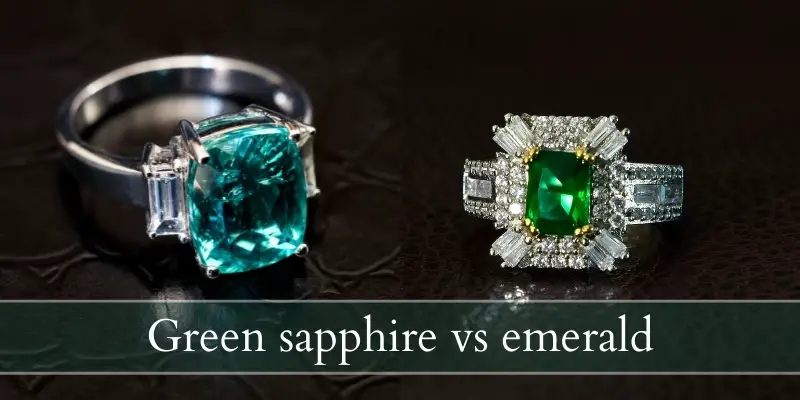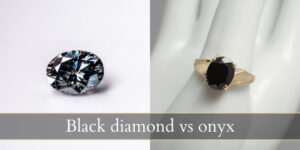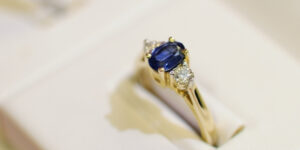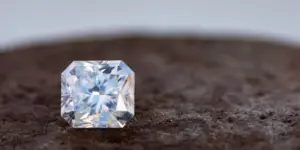Sapphires and emeralds are two very different gems that command a whole lot of respect, and a very high price tag. You usually know which is which, but have you heard of green sapphires ? Apparently there’s such a thing, and people often mistake a green sapphire for an emerald.
Today we’re comparing green sapphires and emeralds, seeing their key differences, and helping you choose which would work best for your situation. Read on !

Green sapphire vs emerald
Green sapphires tend to be darker and less color saturated than emeralds, while emeralds tend to be a vivid mint green with a blue tinge. An emerald is far more expensive than a green sapphire, usually double the price. And emeralds are generally softer than green sapphires, so they would scratch and chip easier than a green sapphire would. There is also higher clarity to be found in a green sapphire, while emeralds tend to look cloudier, and more included.
Both gemstones are beautiful in their own way and deserve a lot of credit. Let’s look at them separately and them compare then in greater detail.
What is green sapphire ?
A green sapphire is one of the many colors a sapphire can show, and it’s more of a grey tinted sort of green. Sapphires are best known for their cornflower blue shade, but in truth all colors of corundum except red are called sapphire, including green ones. You won’t find green sapphires as easily as you will blue, pink, or yellow.
What is emerald ?
Emerald is a type of beryl, the most famous kind there is. Emeralds are the green variation of beryl, other variations being morganite (peach-pink), heliodor (yellow), and aquamarine (very light blue). Emeralds are very easy to find, but command a very high price so it’s work taking a look at whether green sapphires would be a better choice.
1. Green sapphires are more durable than emeralds
Green sapphires are still a version of corundum, and as such they have a very high Mohs rating of 9. The Mohs rating is a way of measuring a gemstone’s hardness, its resistance to scratches and chipping. The higher the score, the harder the gem. Diamonds for example have a rating of 10, the highest.
Emeralds have a Mohs rating of 7.50-8 which is still fairly tough but still softer than green sapphires. When it comes to jewelry that you want to wear every day, such as an engagement ring, you’re looking for something that will withstand daily wear and tear. Perhaps you want to pass it down to future generations. Or perhaps you simply like knowing the gem is still intact, decades later.
In any case, a green sapphire will serve you for far longer than an emerald. This does not mean an emerald will shatter after a few days, but it has a higher chance of scratching or chipping.
Both emeralds and sapphires are often included and are often treated for color and clarity. But green sapphires come out on top here.
2. Emeralds are more expensive than green sapphires
Emeralds are THE green gemstone. It’s what most people think of when you say you want a green gem. As such, it’s become one of the most expensive gemstones, after rubies and diamonds.
So when you’re thinking of getting an emerald, be prepared. A very fine quality emerald with vivid green color and eye-clean will usually sell for about $6,000 per carat. The price goes up if the gemstone has a perfect color or clarity without any additional treatment. Many emeralds are oiled, or have their cracks filled with resin. This improves clarity but lowers price.
Read also: Garnet VS Spinel
As for green sapphires, their price is much lower, about half the price of an emerald. An eye-clean green sapphire with good color will sell for $2,500-$3,000 per carat, depending on how vivid the color is. The issue with green sapphires is that they often tend to have a grey cast so their green will always be very different from an emerald.
3. Green sapphires have a yellow-grey-blue tint, emeralds are brighter green
There is a significant color difference between green sapphires and emeralds. Emeralds are unmistakably green, and they have a slight blue hue to them. Perhaps the best way to describe them would be mint green, a deep, vivid green with a blue undertone, or perhaps sea green. The better the color, the more expensive the emerald.
A green sapphire has a very wide range of green. You can find it in various saturations of green, but it will always have a grey or yellow tint to it. So a green sapphire will often appear a bit muddy, despite having exceptional clarity. Some green sapphires may appear like a metallic light green-grey, some may be a dark blue-green and some may be a vivid green-yellow. Getting a green sapphire of the same shade as an emerald is difficult but can be done, just have patience.
4. Emeralds tend to show more inclusions
When it comes to inclusions both green sapphires and emeralds have them, but a little differently. Like many gemstones, green sapphires are often heated for color, to further develop it. This also dissolves some of the rutile inclusions in the gem, leading to a much clearer gemstone. So, a sapphire, even a green one, will come out looking pretty clear most of the time.
Emeralds are very well known for their inclusions, and most have inclusions that are visible to the naked eye. Emeralds are never heated as that doesn’t help them at all. Instead they are oiled of filled with resin. Both methods aim to fill the various scratches and cracks with something transparent and thus reduce apparent flaws. But those treatments are not timeless and have to be redone after several years.
So in short emeralds are more included and may appear more cloudy than green sapphires, even if the emeralds have been oiled or filled.
Can you use green sapphire instead of emerald ?
A green sapphire can be used in place of an emerald, provided you find a green emerald with a blue-green color and bright enough. The sapphire’s higher hardness will ensure you can wear you jewelry every day, so scratches and chipping won’t be an issue. Green sapphires are also far more affordable than an emerald, so you would end up spending less for a gem that is similar.
An up-close look by someone professional would reveal that it’s not an actual emerald, especially due to the higher clarity of a green sapphire and the generally darker color. But if all you want is a green gem, the green sapphire will work very well.
Other emerald substitutes are possible, such as green tourmaline, green garnet, and good ol’ cubic zirconia. Of course, to be very convincing your faux emerald or simulated emerald would work best as a step-cut, such as emerald cut or baguette. These are the most common cuts for a true emerald.

I’m the main author for jewelrymaterialguide.com. I started this site after we did tons of research before our wedding and noticed that there is information about rings, jewelry, and so on that is really hard to find on the internet.






